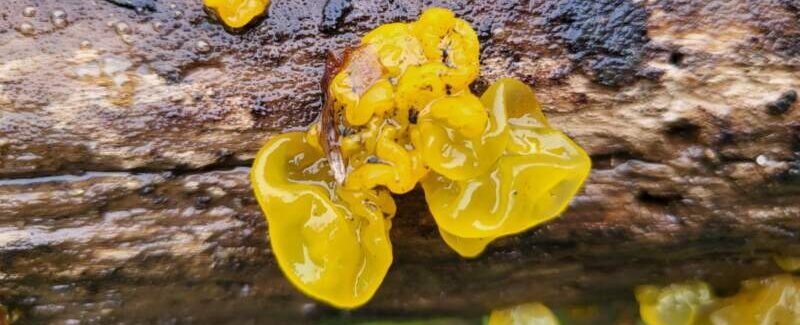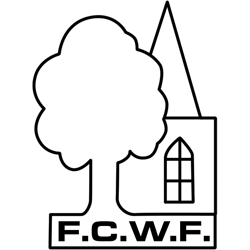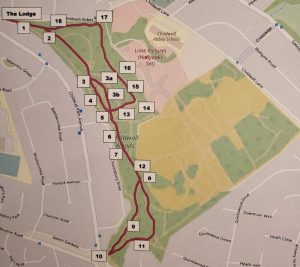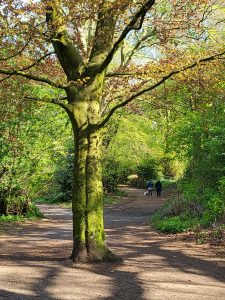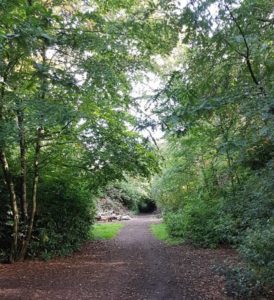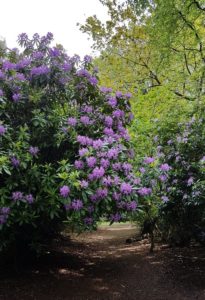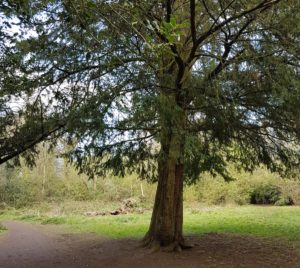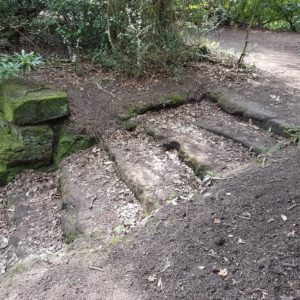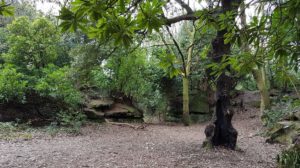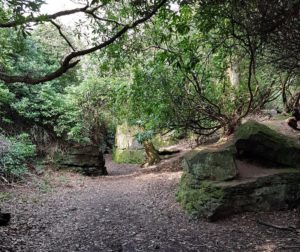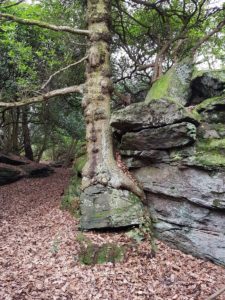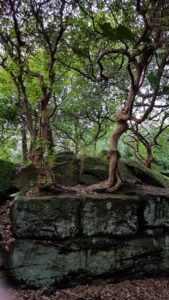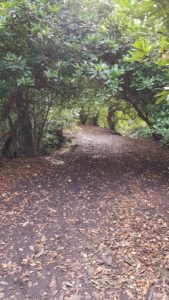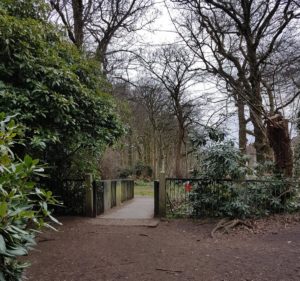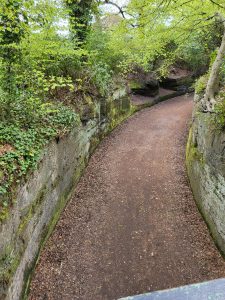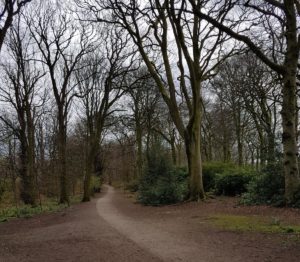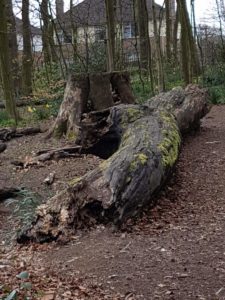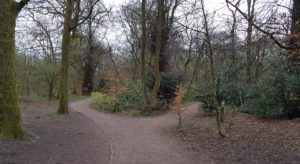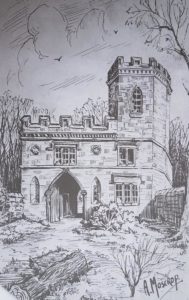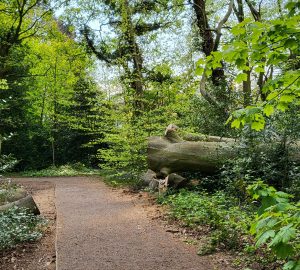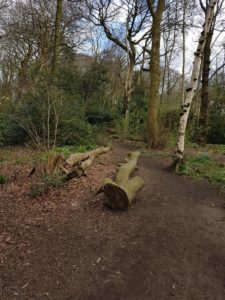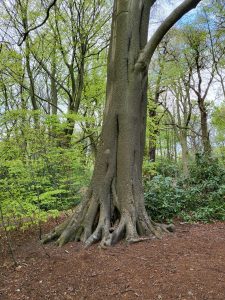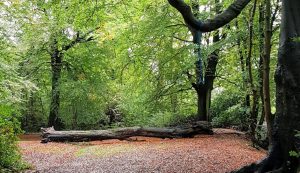The Grounds of Childwall Hall
Approximately 1 hour
Not suitable for buggies or wheelchairs due to steps, and some uneven, narrow paths.
This walk will take you all around ‘The Grounds’ of Childwall Hall (no longer standing) on a circular route starting and ending at the Lodge on Childwall Abbey Road. There is a detour around the Folly with its unique rock structures and contorted trees and you will wander over a sunken carriageway and between veteran trees hundreds of years old, before returning back to the Lodge. For more information on the history of the site See the History page
You will need: A camera and strong shoes. This walk will take you at least an hour depending on your speed but plan for longer as you will not want to rush around these wonderful grounds. All the paths are passable throughout the year but there will be muddy areas in winter, especially around the folly. There are good paths for most of the walk. A buggy or wheelchair would be impractical in parts although fine on the main paths from 1 to 9.
1 The Main Path
Enter Childwall Woods through the Main Gates on Childwall Abbey Road next to the Lodge, and follow the path until it branches in 3 directions. Take the middle path. The path on the left is the one you will return by and the one on the right will take you down the carriageway (Walk 1). The middle path is the main path into the grounds and will be your main pathway during this walk.
2. The path through the Rhododendrons.
Follow the path straight ahead through the Rhododendrons on either side. Now overgrown and wild but once were trimmed and nurtured as ornate garden specimens belonging to the grand Childwall Hall.
Don’t be fooled by their winter colours. Spring dresses these old ladies in their Sunday best.
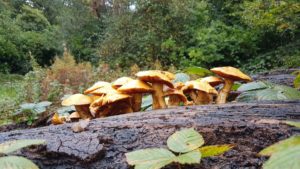
Rustgill (Gymnopilus penetrans)
Follow the path past the large fallen branch at the side of the path and onto the small clearing with the old rotten tree. You never know what will be growing out of it year on year as it breaks down.
Here you will notice an old Yew tree standing as it has for centuries on the edge of the clearing. Walk underneath its branches to the steps further along the path.
3 A Detour to The Folly
On your left, you will notice a set of steps cut into the rock to take you down to The Folly. This is not a suitable route for a buggy or a wheelchair, but for most walkers, it will be passable at all times of the year in strong waterproof shoes.
You can follow these steps down to another set of steps that will take you around The Folly, known locally as Monkey Island.
It is thought that the folly was built to impress visitors and for no practical purpose. When first created it would not have been shaded by large trees and Rhododendrons as it is today but would have been open and bright, a cool spot for an interesting afternoon walk. Which it still is today.
3a The Folly
The Folly is not an easy walk. It is a magical manmade feature of the site and well worth the extra effort to explore it.
Was it cut into the rock or built using huge slabs of sandstone?
What do you think?
The path to the right is often the best and the driest way around while you explore the many interesting features
3b Unique features
There are some wonderful natural features in The Folly, besides those made by man.
The trees in the Folly are wonderfully strange and show how resilient nature can be in establishing a foothold in an unlikely and unfriendly environment.
Walk straight through to the bridge.
4 The Path through the Rhododendrons
If you didn’t take the detour around the Folly carry straight on past the steps, along the wide path between the Folly and the Carriageway. You can look down into each one, the Folly on the left and the Carriageway on the right. A good view into each.
5 The Bridge over the Carriageway
Cross over the bridge taking in the view of the carriageway below.
Here the Bunter Sandstone is cut away to create a gentle curve around to the site of Childwall Hall. Cutting through the sandstone exposed millions of years of rock formation and this is recognised as a Regionally Important Geological Site (RIGS). Walk 1 will take you under the bridge
6 The Main Path through The Grounds
Follow the main path past the old wall at Countisbury Drive and through the veteran trees that shade it during the summer months. This path through the grounds can be seen on ancient maps and the trees on either side reflect its age.
7 The site of a felled tree
Don’t forget to take in the sights along the way. This felled tree is a lovely place to stop and rest or to look for fungus if the time is right.
Depending on the season you may see Bluebells, Wood Anemone, Wild garlic or Lesser Calendine, mostly planted by Friends of Childwall Woods and Fields last autumn.
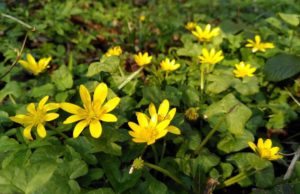
Lesser Celandine – Matthew Jones
8 The Path to Woolton Road
Take the path on the right to continue through ‘the grounds’ as the path on the left will take you down through the willow plantation or to the gate on Quickswood Close.
9. The remains of a second lodge
Follow the path through ‘the grounds’ to the gate on Woolton Road. As you pass along this path you will pass the ruins of the second Lodge that used to stand on the site and can still be found marked on the 1849 map. All that’s left is the low wall just visible in the ground. An echo of the past.
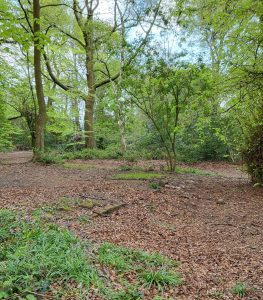
The remains of the second lodge.
The artist’s impression of the second lodge shows the path going through the middle. Not the path you walk on today, that seems to have shifted slightly.
Notice the turrets to reflect the character of Childwall Hall.
As you continue along the path toward Woolton Rd you will walk past the trunk of a huge fallen Beech tree. Another victim of storm Arwen.
10 The Route Back
Continue to the west gate of Childwall Woods which takes you out onto Woolton Road.
If you don’t want to leave the woods, make a left turn and walk back following the path to the right of this fallen branch.
This path is much narrower but will take you back through the woods on the opposite side, past the path that leads down onto the top field and under some wonderful old trees.
Although well worn this path is not suitable for a wheelchair or a buggy. A safer way would be to turn and go back on the path you came on.
11. Through the trees
Follow the path around the southwest boundary of the woods next to the houses of Cabot Green. Keep the fence on your right.
Spare a moment to look at the huge beech trees in this section of the grounds. You might even notice one of our veteran trees on your left. A large beech measuring 4.57m around its trunk. Undoubtedly one of the first trees on the site, 200 -300 years ago.
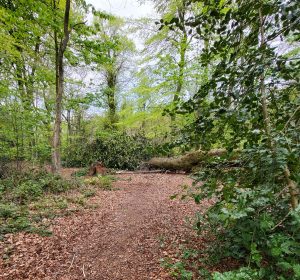
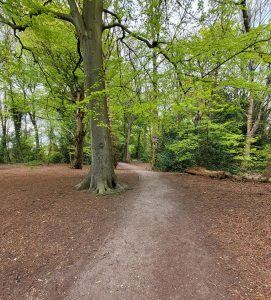
Go straight ahead towards the fallen tree and you will notice a path on your left just past the fallen tree.
This will take you back past the top field.
12. The Dipping Pond
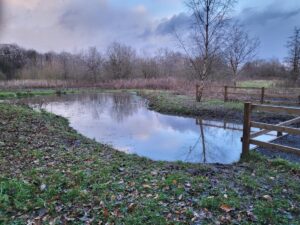
As you continue along this path towards the Countisbury Drive entrance, take a short detour onto the top field and take a look at the dipping pond.
As part of the Access and Habitat Improvement Project, the pond was the first standing water on the site, which is great for wildlife and walkers.
This path will take you again past some of our biggest and oldest beech trees.
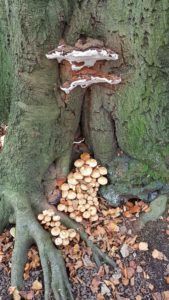
Artist Polypore (Ganoderma applanatum) and Sulphur Tuft (Hypholoma fasciculare)
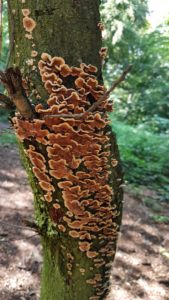
Hairy Curtain Crust (Stereum hirsutum)
Look out for the many types of wood rot fungus that can be found most months of the year in Childwall Woods.
The woods date back to the 1700s and there are many fallen trees and branches giving rise to the most interesting fungi, from giant Artist Polypores to Hairy Curtain Crust. You will find some if you take your time.
The specimens shown here are on living trees.
13. The ornamental woods.
Follow the path back over the bridge and turn sharp right. Looking down the hill you will see a large fallen tree.
This is one of the original paths created for the owners of Childwall Hall for their strolls around the ornamental woods which they had created. If you look carefully you can see the old pebble path leading down now crossed by the fallen tree if it isn’t covered with leaves.
14. The Veteran Sweet Chestnut Trees.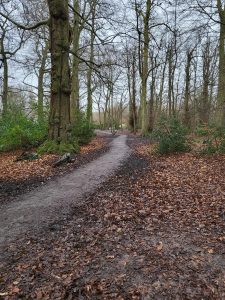
Just past the fallen tree look to your right at the 3 large sweet Chestnut Trees just past the end of the carriageway.
Look ahead and that is the site of the old Hall
The hall is gone but the trees remain, huge and beautiful and the home for many living things from insects to fungi and birds.
If you are lucky enough to be in the woods in spring this is a good place to see English Bluebells, making the most of the sun before the leaves appear. And a favourite spot for woodpeckers too as soon as a walker has passed.
15 The old trees around the Hall
Turn left just past the fallen tree and follow the path under the line of huge veteran Beech trees.
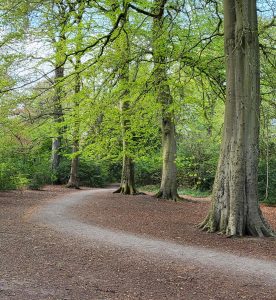
You can’t miss the upturned roots of another fallen tree on your right as you walk by the beech trees. With its ever changing outcrops of fungus, depending on the time of year of course.
Move on past the upturned tree on your right and you will join a narrower path lined by Yew trees, a reminder of the days when the Chapel was just off to the right of the path.
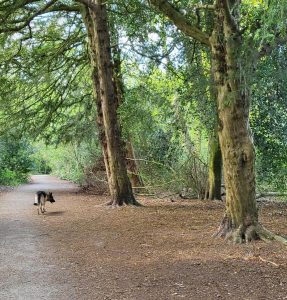
Follow this narrower path round through the Rhododendrons and past the yew trees, once on the site of the private chapel.
Remains of the chapel can still be found if you go down towards Lime Pictures at this point, but beware, the path has been covered with fallen trees after many storms
17. The Path to the Main Gate
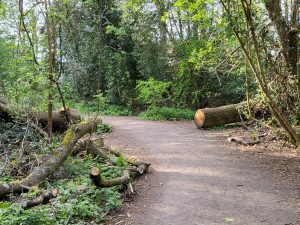
Follow the path until you come to a sharp bend. The remains of a large oak can still be seen here. Another victim of storm Arwen.
Continue past the side gate and back towards the main gate by the lodge.
Don’t forget to look left at the sea of daffodils in April or to catch the fragrance of the wild garlic as you pass.
This Northernmost part of the grounds has some of the largest and oldest veteran beech trees on the site lined up along the path to the Lodge.
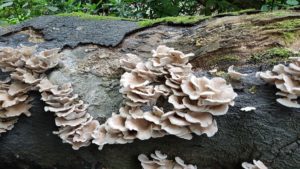
Oyster Mushrooms (Pleurotus ostreatus)
Beautiful and sometimes edible fungus appears and disappears according to the time of year, but if the fungus isn’t there to catch your eye then maybe the Peacock butterflies will be, or the Speckled Wood varieties.
Maybe it will be the blue of the Bluebells that will brighten your day, or the rapping of a woodpecker, or meeting a squirrel eye to eye.
There will be something.
18. The start of the carriageway
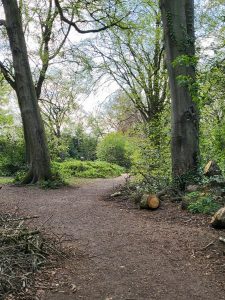
Follow the path to the right, past another fallen tree.
In spring you will be rewarded by the many spring flowers along the way but whatever time of year you come to the nature reserve there will be something unforgettable waiting to surprise you on your walk.
An hour well spent taking in the sights, sounds, and beauty of Childwall Woods.
Different every time but always wonderful.
B Cameron
Photographs are the author’s own unless otherwise stated.
